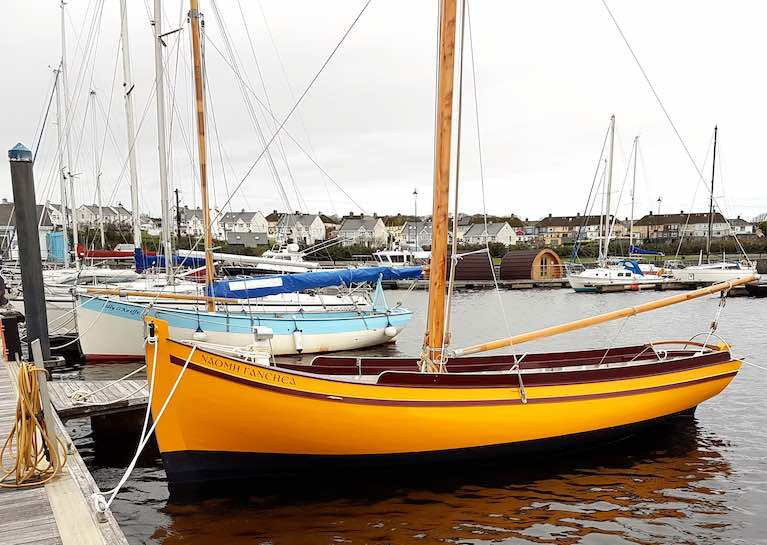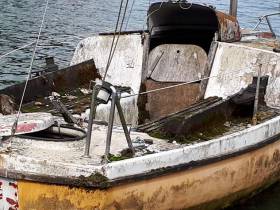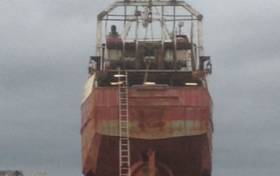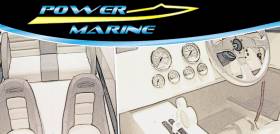Displaying items by tag: boatyard
World's Largest Sport Fishing Boat Nears Completion in Holland
Project 406, the world’s largest sportfishing boat, celebrated a milestone moment on 11 March with the turning of its hull. Designed by Dutch design studio Vripack, and under construction at Royal Huisman’s newbuild headquarters in Vollenhove, the Netherlands, the superyacht’s exceptional lines were on full display.
A long, sweeping bow, high bulwarks and the clear outline of the fishing cockpit mark the 52m yacht out as the most serious contender ever to be constructed in the specialist sportfish category. The characteristic low, uncluttered aft cockpit is close to the water for easy access to gear and a clear sight of the catch. Seating immediately above will provide a superb platform to follow the action as it unfolds below.
Project 406 - Hull turning Sport Fish from Vripack Design on Vimeo.
With her six towering decks, Project 406 will cut a unique profile on the water. Not only will she be the largest but also the most luxurious, finely appointed and meticulously engineered sportfish anywhere in the world.

The Alustar® aluminium hull – prepared and detailed by Royal Huisman’s in-house team – offers strength and resilience. It also achieves a lighter weight to ensure a smooth and efficient passage to the fishing grounds.
Project 406 possesses the finesse of a contemporary superyacht and the performance of a high calibre sportfisher, say the designers.
Electric Power Adds a New Element to Kilrush-Built Traditional Galway Bay Gleoiteog
Steve Morris of Kilrush Boatyard and his lead boat-builder Dan Mill are busy these days, as their team have two further Dublin Bay 21s under construction for the Hal Sisk/Fionan de Barra project, and this week they launched the new "Gleoiteog with a difference" for a local couple who sought a traditional sailing boat with impeccable ecological credentials. Thus while they realised auxiliary power was a requirement, the clients insisted on an electric auxiliary unit, and this has been achieved with a Torqueedo turbine incorporated in the rudder, which suggests there's quite a bit of Antipodean savvy and ingenuity being applied to the boat-building scene down in West Clare.
 Steve Morris and Dan Mill are bringing Antipodean skill and ingenuity to the boat-building scene in West Clare. Photo: W M Nixon
Steve Morris and Dan Mill are bringing Antipodean skill and ingenuity to the boat-building scene in West Clare. Photo: W M Nixon
From ahead, the new boat looks like an interesting refinement to the traditional concept for a 23ft gleoiteog, in which the length is 23ft from the aft side of the stem to the transom, meaning that under other jurisdictions she'd be regarded as a 24-footer.
Thus as they have their own way of doing things in Galway Bay, we don't quite know what they'll make of What Steve Did Next. For although he took the lines off a classic gleoiteog belonging to a friend in The Claddagh in Galway City, he subsequently raised the topsides a bit and increased the beam before beginning construction for the Kilrush customers.
Be that as it may, when seen from ahead first while under construction, and then after she'd emerged newly-finished from the shed in recent days, there's no doubt that the true spirit of a curvaceous gleiteog had been achieved, made all the more impressive by gleaming topsides which have been painted in a glorious luminous colour for which "deep yellow" is scarcely appropriate.
 Although some modifications had been made to lines taken off a traditional gleoiteog, as the new boat took shape there was no doubting her true credentials. Photo: Steve Morris
Although some modifications had been made to lines taken off a traditional gleoiteog, as the new boat took shape there was no doubting her true credentials. Photo: Steve Morris
 The Naomh Fanchea achieves an elegant balance between traditional precepts and classic boat standards, but the view from ahead hides her surprise power-unit feature. Photo: Steve Morris
The Naomh Fanchea achieves an elegant balance between traditional precepts and classic boat standards, but the view from ahead hides her surprise power-unit feature. Photo: Steve Morris
 The Torqueedo power pod may be mounted in and on the lower trailing edge of the rudder, but it is located in such a way that the propeller is working in clear water for maximum thrust. Photo: Steve Morris
The Torqueedo power pod may be mounted in and on the lower trailing edge of the rudder, but it is located in such a way that the propeller is working in clear water for maximum thrust. Photo: Steve Morris
It's when you go round to the transom that the secret weapon is found, a 4kw Torqueedo pod mounted partially within the foot of the rudder with controls - and power from two Torqueedo lithium batteries in the boat – transmitted by a substantial cable from the transom into the rudderhead and then led down within the rudder itself to the power pod.
 The propeller installed, with the transmission cable socketed into the transom and the lower edge of the cheek of the rudder-head. Photo: Steve Morris
The propeller installed, with the transmission cable socketed into the transom and the lower edge of the cheek of the rudder-head. Photo: Steve Morris
 The view from astern reveals the increased beam and the way in which the rudder-mounted propellor is kept in clear water, while getting some protection from the fact that the foot of the rudder is fitted a few inches above the bottom of the keel.
The view from astern reveals the increased beam and the way in which the rudder-mounted propellor is kept in clear water, while getting some protection from the fact that the foot of the rudder is fitted a few inches above the bottom of the keel.
In due course, there'll be time to test Naomh Fanchea's performance with the first traditional sunrise sail round Scattery Island under the sails which have been made for her by Yannick Lemonnier of Quantum Sails in Galway, but with such a novel auxiliary motive unit, the immediate curiosity was about performance and range under power.
Torqueedo provides a sophisticated monitoring system which enables you to evaluate speed against range in real-time, which is very much a primary concern at the present developmental stage of battery power longevity. The news is that while Naomh Fanchea could clock 6.5 knots at full power, the available reserves were almost visibly depleting, but at 4.5 knots the unit was confident of 7.5 hours usage, suggesting a range of 33 miles.
 Smooth and silent – Naomh Fanchea under way in Kilrush Creek. Photo: Steve Morris
Smooth and silent – Naomh Fanchea under way in Kilrush Creek. Photo: Steve Morris
For those who think in terms of a range under engine of hundreds of miles, this may seem scarcely worthy of consideration. But for environmentally-conscious owners who live locally and will be using the boat for day sailing with the power unit only essential for accessing or exiting the lock at Kilrush and perhaps getting over the last few miles home on a calm evening, this is all that is required.
As for general handling and manoeuvring under power, this is described as excellent. And as Naomh Fanchea will be based in Kilrush Marina, access to shore power is immediate for connection to each lithium battery's own unit, which enables recharging from totally flat - something only rarely achieved - within 11 hours. In other words, you simply leave the boat plugged in overnight.
In addition, a separate 12-volt battery which is kept up to power by its own solar panel is used to service lights and instruments, the final addition to a very eco-friendly setup which sits well within the ambience of this particularly elegant example of the classic gleioteog.
 A sacred place – the Round Tower on Scattery Island off Kilrush in the Shannon Estuary. In keeping with local tradition, the new Naomh Fanchea will be christened by having her first sail at sunrise round Scattery.
A sacred place – the Round Tower on Scattery Island off Kilrush in the Shannon Estuary. In keeping with local tradition, the new Naomh Fanchea will be christened by having her first sail at sunrise round Scattery.
Abandoned Boats: What is it that Makes Owners Abandon Their Boats?
I don’t mean abandon in emergency at sea, I mean leave them to rot away in boatyards or on rivers or harbour moorings or in boatyards .. to ignore them …. deliberately forget about them …perhaps hoping never to be bothered with them again?
I am finding it hard to understand how anyone who owned and sailed a yacht, can just leave it and never go back, but I’ve been noticing them more in different parts of the country.
There are corners of every boatyard, as far as I can ascertain, where boats are moved as the location of last resort…. Boats that owners don’t or won’t admit to, maybe they can’t afford to pay for them any longer … but the plastic boats of today, as we heard in a recent podcast from that great afficionado of boats, Hal Sisk, will last for … well… no one really knows how long they will last….
There may be and could be reasons, which I discuss in this week’s podcast, but I just can’t understand why people go through all the challenge and difficulty of owning a boat and then abandon it … Boats have been abandoned in yards or on moorings – where, ofen amazingly, ropes still hold them in position after being long-neglected …..
Listen to the podcast here:
Tom MacSweeney presents the maritime programme, THIS ISLAND NATION
Launch Your Boat Time!
It’s launching time at Castlepoint Boatyard at Crosshaven in Cork Harbour where I keep SCRIBBLER II.
That’s my Sigma 33, named rather appropriately for a journalist/scribe, as I’ve been told. The first SCRIBBLER was a Ruffian 23, much sailed and enjoyed by the family to whom she gave great service. The main drawback was the low head room in the cabin, but she was a great boat and served us well in racing and cruising over the years. From her I moved onto a Sadler 25, a grand boat too that gave great racing. From her I moved to the Sigma.
The change from masthead to fractional rig was an adjustment which gave me a testing time. Over the past week or so I’ve been getting her ready for launch, which time arrived this week and began with my first port-of-call to the ‘rest-and-recreation clinic’ as I call it of O’Connell’s Batteries on the Marina Commercial Park on the banks of the River Lee in Cork where Scribbler’s batteries had lain under care since lay-up last October. Throughout my sailing career I’ve been advised that battery care is an essential component of safety. From the annual rescue statistics, there are owners who should give more care to their boat batteries. Then a rigging check and adjustment carried out by a good sailing contact, Harry Lewis and a guard rail for crew safety replaced on his recommendation. There can be no compromise with safety
Castlepoint was busy and gradually losing its population as boats were launched and Scribbler’s turn approached. Billy Curran and his staff helped me with checks and maintenance. Taking a boat racing puts responsibility on the owner/Skipper towards the crew who will sail it. That too is an issue on which those who introduced me to sailing placed emphasis.
Preparing a boat properly is vital because sailing is a sport where there is no ‘even playing pitch.’ Conditions change from one day to another, even change during a race and not only the crew, but also the boat, must be able to cope.
So for my weekly Podcast, come aboard SCRIBBLER II as I make the final checks myself and, perhaps, smile and laugh as you hear what you may have encountered yourself aboard your own pride and joy...
Passenger Boat Heads to Howth for Overhaul Prior to Seasonal Cruises
#Boatyard – The latest customer at Howth Boatyard, Co. Dublin is a 120 passenger excursion boat that operates cruises from the harbour to Ireland’s Eye just offshore and around Dublin Bay, writes Jehan Ashmore.
The boat St. Bridget operates for Dublin Bay Cruises had departed Grand Canal Dock Basin yesterday having taken a winter lay-up berth. Before the steel-hulled vessel headed for the boatyard for routine maintenance overhaul, St. Bridget berthed in the Dublin city centre. This is from where seasonal cruises offering panoramic views of the bay begin in April linking Howth and Dun Laoghaire harbours.
St. Bridget has also over the years while off service in the winter taken a berth in Dun Laoghaire Harbour. This has been at the berth adjacent to where HSS Stena Explorer used alongside St. Micheals Wharf until the fastferry service to Holyhead, Wales closed operations in Autumn of 2014.
Since then Dun Laoghaire Harbour has been left with this sole passenger commercial service, albeit for domestic excursion purposes. In addition the former Aran Islands serving 25m long ferry also offers evening cruises to Killiney Bay.
Another vessel of a similar length at Howth Boatyard last week was a UK flagged highspeed craft crew transfer boat, MSC Kraver. The 167 gross tonnage craft had sailed from Birkenhead.
Earlier this month, Wicklow based tug workboat Husky had too availed of the yard’s 600 tonnes ‘Syncrolift’ facility. This sees boats raised out of the water and taken across to the boatyard set back from the quayside on the West Pier.
Husky Heads Home from Howth Harbour
#Towage – Alpha Marine’s tug-workboat Husky headed to her homeport of Wicklow Port this morning having been at Howth Boatyard, writes Jehan Ashmore.
The robust looking Belfast registered 8 tonnes bollard pull tug had used the boat-haul or ‘Synchrolift’ facility of the yard. This is operated by John Leonard Shipwright & Co.
Small craft are built at the yard located on West Pier, along with refurbishment and repairs of small vessels all the way up to a 600 tonne trawler. Also to be found lining the West Pier are fishing related businesses among them restaurants using the catch of the day.
Husky over the years has been the mainstay of operations for the multi-disciplinary marine organisation until recently known as Island Shipping.
An example of larger scale work tasked to Husky involved hoving the large Jack-up Barge Wavewalker 1 around Wicklow Port and to the Arklow Bank Offshore Windfarm. Other work has involved use of the workboat’s stern mounted A-frame for bed levelling plough and can be easily configured for multi-beam, geophysical and environmental surveys.
Fleetmates of the Husky are a wind-farm support and crew transfer vessel and an inshore survey-dive crew boat.
Propelled by twin-screws, the 21m Huskey arrived at the Wicklow to berth at the North Quay on the River Vartry. The tug shares the quay with the local fishing trawler fleet. Among them is Angela Madeline, which after a day’s fishing last weekend passed general cargoship Bounder (see report/photo).
In port today, notably is another short-sea trader Velox in which Afloat will have more to report. On the opposite bank at the South Quay is berthed the beam-trawler Bridget Carmel.
Power Marine, Malahide Based Boat Builder, Seeks Workshop Staff
Power Marine, a Malahide County Dublin based boat builder, is seeking a workshop staff member.
The successful candidate should have working knowledge of composites and a reasonable understanding of boat repair and maintenance.
Please forward CV to [email protected]
MGM Boat Yard Lifts Dun Laoghaire & Howth RNLI Lifeboats
With just over three weeks til the clocks go forward and with the smell of antifouling in the air at Dun Laoghaire Harbour, it can only mean one thing; the Irish summer boating season is just round the corner. Boatyards around the country are getting busy in anticipation of a great 2016 season. Yesterday and today, both the Howth and Dun Laoghaire RNLI Lifeboats are being lifted on MGM Boatyard's 50–ton travel hoist (the only such hoist in Dublin Bay) for maintenance and service work that includes antifouling and anode changing.
Howth & Dun Laoghaire Lifeboats lifted yesterday & today for antifouling and anode changing pic.twitter.com/KlJJaajZpq
— MGM Boatyard (@BoatyardMgm) 2 March 2016
MGM Boats offer a wide range of boatyard services including lifting, pressure washing, block off and launching.
A Question Asked in a Kerry Boatyard
#islandnation – "Now, why would you say that Tom?"
And when Fionán Murphy rightly challenged me about my question, I did ask myself why I had just said:
"It's unusual, isn't it, for a boat for Norway to be built in Kerry?"
"I don't know why you would say Kerry, Tom," Fionán said back to me. "Ireland maybe, but why would you say 'Kerry'? The guy involved found us, came over to us and we have a fantastic relationship with him. He has been here for two months and he will be here with us until the boat is finished. It is a great place to do business because the Norwegian currency is very strong. To do anything in Norway costs a fortune, so they are getting great value for money here and we are still getting a good price for our product. It is a great place to do business and if we can do more business there, it will be fantastic."
It was a bright exchange which I enjoyed, because it is good for an interviewer to be challenged. I was trained in radio broadcasting in the days when the interviewee was the most important person, not the interviewer. Too much of radio now centres on the personality of the programme presenter, not the interviewee. I still believe that the interviewee is the most important part of an interview, so Fionán and myself chuckled at my gaffe and as Managing Director and the man who owns Murphy Marine Services on the Shore Road in Valentia Island and so an islander, he made a strong point about Kerry and the importance of our offshore islands. I was talking with him and other members of the island community who were making the point that the Government does not show enough commitment to Ireland's offshore islands. I interviewed Fionán about the future of the island and how his boatyard, which builds, maintains and stores boats, is going.
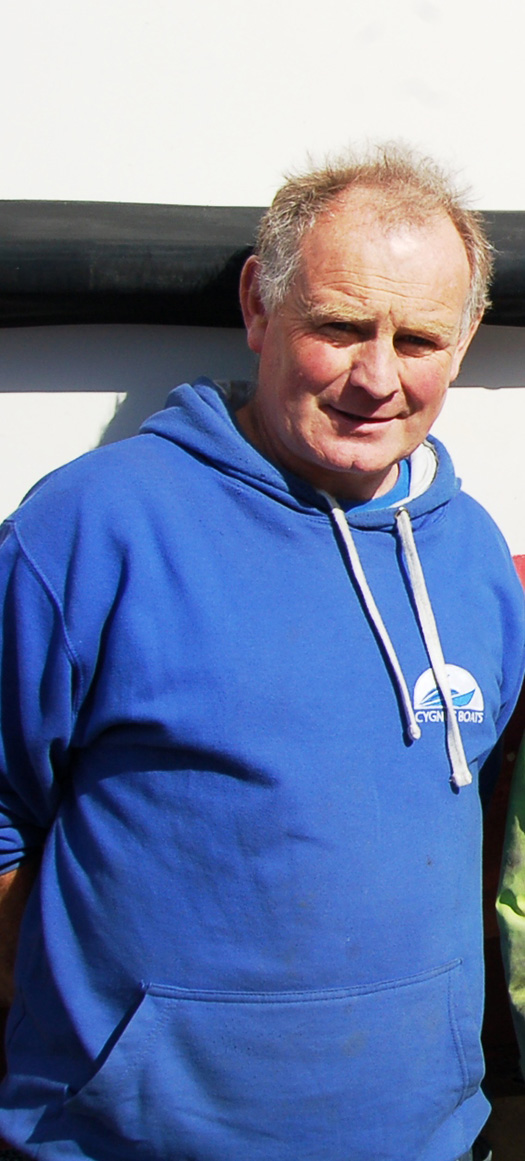
Fionán Murphy of Murphy Marine Services, Valentia Island
"Our predominant thing is new builds. If we get four-to-five of those a year we would be very happy. This keeps jobs on the island and that is what we need."
Fionán is also Chairman of the island's Development Company:
"Rural Ireland is in decline and we are doing what we can, but the island needs people and people need jobs to stay here. Islands need special recognition from the Government."
Fionán tells me in the interview, which you can hear here, how he started the yard fourteen years ago and how it has developed to its present stage of building boats which are sold all over Europe and how he overcame the economic, recessionary downturn.
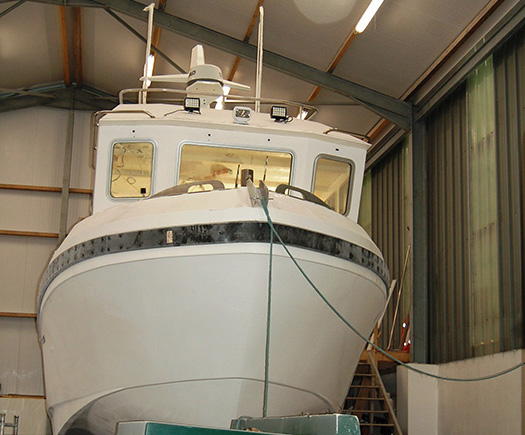
A new fishing vessel built in Valentia and bound for Norway
You can hear him on this current edition of THIS ISLAND NATION, Ireland's niche maritime programme, now broadcast on seven radio stations around the country and on this website. Also on the programme, the value of maritime safety training is emphasised by the interim Chief Executive of Bord Iascaigh Mhara, Michael Keatinge, who outlines how three fishermen's lives were saved when their boat capsized off the East Coast, because they had done the BIM safety course.
There's a lot more to be heard on THIS ISLAND NATION and you can Email me direct about the programme to: [email protected] or leave a comment below.
A New Tall Ship For Ireland? It's Back to The Future
#tallship – The Tall Ships return to Ireland in spectacular style this summer with a major fleet assembly in Belfast from Thursday 2nd to Sunday 5th July for the beginning of the season's Tall Ships Races, organised by Sail Training International. The seagoing programme will have a strong Scandinavian emphasis in 2015, with the route - some of which is racing, other sections at your own speed – starting from Belfast to go on Aalesund in western Norway for 16th to 18th July, thence to Kristiansand (25th to 28th July), which is immediately east of Norway's south point, and then on to conclude at Aalborg in northern Denmark from 1st to 4th August.
But before leaving Northern Ireland with the potentially very spectacular Parade of Sail down Belfast Lough on Sunday July 5th, the celebrations will be mighty. The fleet's visit will be the central part of the Lidl Belfast Titanic Maritime Festival, which will include everything from popular family fun happenings with concerts and fireworks displays – the full works, in other words – right up to high–powered corporate entertainment attractions.
As for the ships, there will be more than enough for any traditional rig and tall ship enthusiast to spend a week drooling over. In all, as many as eighty vessels of all sizes are expected. But more importantly, at least twenty of them will be serious Tall Ships, proper Class A square riggers of at least 40 metres in length, which is double the number which took part in their last visit to Belfast, back in 2009.
That smaller fleet of six years ago seemed decidedly spectacular to most of us at the time. So the vision of a doubling of proper Tall Ship numbers in Belfast Harbour is something we can only begin to imagine. But when you've a fleet which will include Class A ships of the calibre of the new Alexander von Humboldt from Germany, Norway's two beauties Christian Radich and Sorlandet, the much-loved Europa from the Netherlands, George Stage from Denmark, and the extraordinary Shtandart from Russia which is a re-creation of an 18th Century vessel built for Emperor Peter the Great, you're only starting, as that's to name only six vessels – what we'll be seeing will be a truly rare gathering of the crème de la creme.
So although it would be stretching it to think that a small country like Ireland should aspire to having a major full-rigged vessel, we mustn't forget that for 27 glorious years we did have our own much-admired miniature Tall Ship, the gallant 84–ft brigantine Asgard II. Six-and-a-half years years after her loss, it's time and more for her to be replaced. W M Nixon takes a look at what's been going on behind the scenes in the world of sail training in Ireland and finds that, in the end, we may find ourselves with a ship which will look very like a concept first aired for Irish sail training way back in 1954.
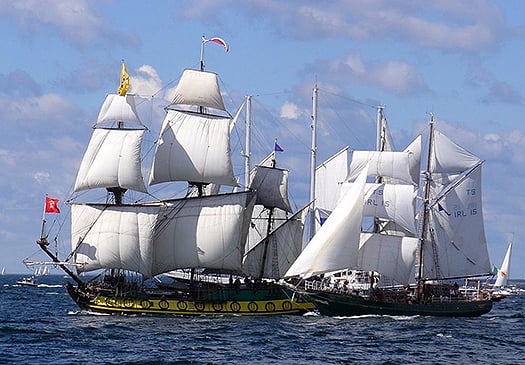
The pain of it. You search out a photo of Shtandart, the remarkable Russian re-creation of an 18th century ship, and you find that Asgard II is sailing beside her
It was while sourcing a photo of Russia's unusual sail training ship Shtandart that the pain of the loss of Asgard II emerged again. It's always there, just below the surface. But it's usually kept in place by the thought that we have to move on, that worse things happened during the grim years of Ireland plunging ever deeper into recession, and that while our beloved ship did indeed sink, no lives were loss and her abandonment was carried out in an exercise of exemplary seamanship.
Yet up came the photo of the Shtandard, and there right beside her was Asgard II, sailing merrily along on what's probably the Baltic, and flying the flag for Ireland with her usual grace and charm. The pain of seeing her doing what she did best really was intense. She is much mourned by everyone who knew her, and particularly those who crewed aboard her. All three of my sons sailed on her as trainees, they all had themselves a great time, and two of them enjoyed it so much they repeated the experience and both became Watch Leaders. It was very gratifying to find afterwards, when you went out into the big wide world and put "Watch Leader Asgard II" on your CV, that it counted for something significant in international seafaring terms.
But as a sailing family with other boat options to fall back on, we didn't feel Asgard II's loss nearly as acutely as those country folk for whom the ship provided the only access to the exciting new world of life on the high seas.

Elaine Byrne vividly recalls how much she appreciated sailing on Asgard II, and how she and her siblings, growing up in the depths of rural Ireland, came to regard the experience of sailing as a trainee on the ship as a "Rite of Passage" through young adulthood
The noted international investigative researcher, academic and journalist Dr Elaine Byrne is from the Carlow/Wicklow border, the oldest of seven children in a farming family where the household income is augmented with a funeral undertaking business attached to a pub in which she still occasionally works. Thus her background is just about as far as it's possible to be from Ireland's limited maritime community. Yet thanks to Asgard II, she was able to take a step into the unknown world of the high seas as a trainee on board, and liked it so much that over the years she spent two months in all aboard Asgard II, graduating through the Watch Leader scheme and sailing in the Tall Ships programmes of races and cruises-in-company
Down in the depths of the country, her new experiences changed the Byrne family's perceptions of seafaring. Elaine Byrne writes:
"Four of my siblings (then) had the opportunity to sail on Asgard II. If it were not for Asgard II, my family would never have had the chance to sail, as we did not live near the sea, nor had the financial resources to do so. The Asgard II played a large role in our family life as it became a Rite of Passage to sail on board her. My two youngest siblings did not sail on the Asgard II because she sank, which they much regret".
She continues: "Apart from the discipline of sailing and the adventure of new experiences and countries, the Asgard brought people of different social class and background together. There are few experiences which can achieve so much during the formative years of young adulthood"
That's it from the heart – and from the heart of the country too, from l'Irlande profonde. So, as the economy starts to pick up again, when you've heard the real meaning of Asgard II expressed so directly then it's time to expect some proper tall ship action for Ireland in the near future. But it's not going to be a simple business. So maybe we should take quick canter through the convoluted story of how Asgard II came into being, in the realization that in its way, creating her successor is proving to be every bit as complex.
As we shall see, the story actually goes back earlier, but we'll begin in 1961 when Erskine Childers's historic 1905-built 51ft ketch Asgard was bought and brought back by the Irish government under some effective public pressure. It was assumed that a vessel of this size – quite a large yacht by the Irish standards of the time – would make an ideal sail training vessel and floating ambassador. It was equally assumed that the Naval Service would be happy to run her. But apart from keen sailing enthusiasts in the Naval Reserve - people like Lt Buddy Thompson and Lt Sean Flood – the Naval Service had enough on its plate with restricted budgets and ageing ships for their primary purpose of fishery patrol.
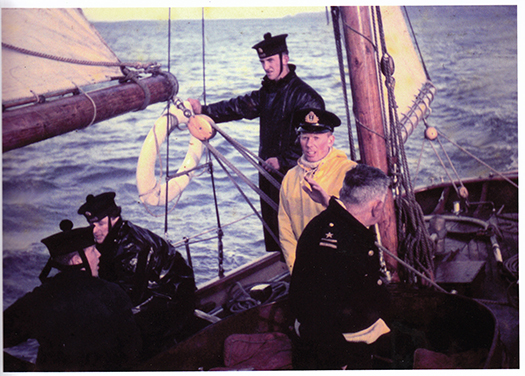
Aboard the first Asgard in 1961 during her brief period in the 1960s as a sail training vessel with the Naval Service – Lt Sean Flood is at the helm
So Asgard was increasingly neglected throughout the 1960s until Charlie Haughey, the new Minister for Finance and the only member of Government with the slightest interest in the sea, was persuaded by the sailing community that Asgard could become a viable sail training ship. In 1968 she was removed from the remit of the Department for Defence into the hands of some rather bewildered officials in the Department for Finance, and a voluntary committee of five experienced sailing people - Coiste an Asgard - was set up to oversee her conversion for sail training use in the boatyard at Malahide, which just happened to be rather less than a million miles from the Minister's constituency.
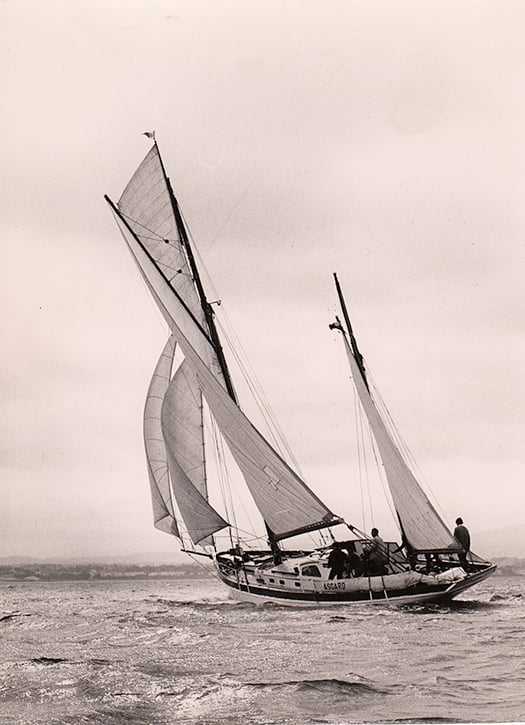
Asgard in her full sail training role in 1970 in Dublin Bay
Asgard was commissioned in her new role in Howth, the scene of her historic gun running in 1914, in the spring of 1969. Under the dedicated command of Captain Eric Healy, the little ship did her very best, but it soon became obvious that her days of active use would be limited by reasons of age, and anyway she was too small to be used for the important sail training vessel roles of providing space to entertain local bigwigs and decision-makers in blazers.
By 1972, the need for a replacement vessel was a matter of growing debate in the sailing community, and during a cruise in West Cork in the summer of 1972, I got talking to Dermot Kennedy of Baltimore out on Cape Clear. Dermot was the man who introduced Glenans to Ireland in 1969, and then he branched out on his own in sail training schools. A man of firm opinions, he reacted with derision to my suggestion that Asgard's replacement should be a modern glassfibre Bermudan ketch, but with enough sails to keep half a dozen trainees busy.
"Nonsense" snorted Dermot. "Ireland needs a real sailing ship, a miniature tall ship maybe, but still a real ship, big enough to carry square rig and have a proper clipper bow and capture the imagination and pride of every Irish person who sets eyes on her. And she should be painted dark green just to show she's the Irish sail training ship, and no doubt about it".
Some time that winter I simply mentioned his suggestions in Afloat magazine, and during the Christmas holidays they were read by Jack Tyrrell at his home in Arklow. During his boyhood, in the school holidays he had sailed with his uncle on the Arklow schooner Lady of Avenel, and it had so shaped his development into the man who was capable of running Ireland's most successful boatyard that he had long dreamed of a modern version of the Lady of Avenel to be Ireland's sail training ship.
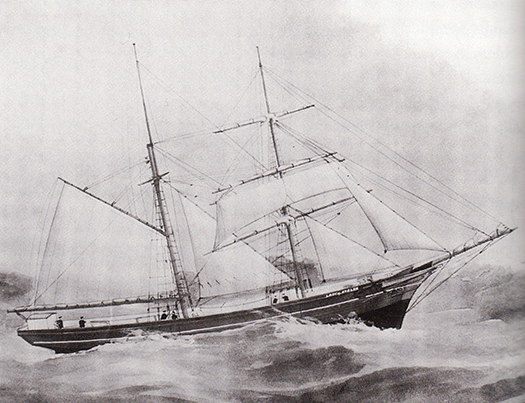
The inspiration – Jack Tyrrell's boyhood experiences aboard Lady of Avenel inspired him to create Ireland's first proper sail training ship
In fact, in 1954 he had sketched out the plans for a 110ft three masted training ship, but Ireland in the 1950s was in the doldrums and the idea got nowhere. Yet the spark was always there, and it was mightily re-kindled by what Dermot Kennedy had said. So at that precise moment, the normal Christmas festivities in the Tyrrell household were over. They'd to continue the celebrations without the head of the family. The great man took himself off down to the little design office in his riverside boatyard, and in clouds of pipe tobacco smoke, he re-drew the lines of the 110ft three master to become an 83ft brigantine, the size reduction meaning that the shop would only need a fulltime crew of five.
Working all hours, he had the proposal drawings finished in time to rejoin his family to see in the New Year. And in the first post after the holiday, we got the drawings at Afloat, and ran them in the February 1973 issue.
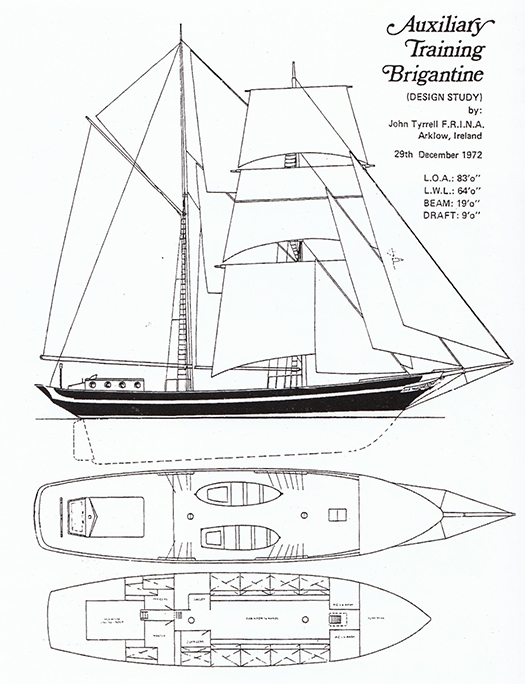
Jack Tyrrell's proposal drawings for the new brigantine, as published in the February 1973 Afloat
In Ireland then as now, most politicians had inscribed in their heads the motto: "There's No Votes In Boats". So after Charlie Haughey had fallen from favour with the Arms Trial of 1970, Coiste an Asgard became an orphan. But 1973 brought a new government, and there was one cabinet minister in it who was proud to proclaim his allegiance to the sea.
Unfortunately for the respectability of the maritime movement in Ireland, our supporters in the higher echelons of politics have often tended to be from the colourful end of the political spectrum, whatever about their placing in the left-right continuum. Thus it was that, at mid-morning on St Patrick's Day 1973, I got an ebullient phone call and an immediate announcement, without the caller saying who he was. "Winkie" he bellowed, "That ship is going to be built. I'll make sure of it. I've just made a ministerial decision".
It emerged that it was our very own new Minister for Defence, Patrick Sarsfield Donegan TD. The enthusiasm for the new ship, engendered by studying Jack Tyrrell's drawings, led to a snap decision which stayed decided, and it all happened in the Department for Defence.
However, it was 1981 by the time the ship was launched, and she looked rather different from Jack Tyrrell's preliminary drawings, though the basic hull shape built in timber was the same sweet lines as originally envisaged, so she was able to sail like a witch. But as for her supporters at Government level, the non-stop cabaret continued. Charlie Haughey had regained power, and by 1981 he was Taoiseach. It was he who had seen to it that the Department of Defence continued to look after the Asgard II project with support from another sailing TD who might not have seen eye–to-eye with him on other matters, Bobby Molloy of Galway.
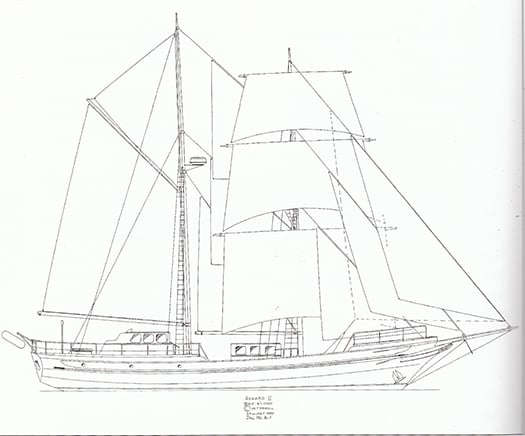
Asgard II in her finished form
So on a March day in 1981, almost exactly twelve years after he'd commissioned the original Asgard in her new role as a sail training vessel, Charlie Haughey took it upon himself to christen the new Asgard II in Arklow basin. And the champagne bottle refused to break. Five or six time he tried, but with no success.
Showing considerable grace under pressure and observed by a large crowd, he quietly took his time undoing all the ribbons and paraphernalia on the big bottle. Then he marched with it up to the new flagship's stem, and hit it a mighty double-handed wallop. The bottle exploded that time, with no mistake. And apart from the usual Haughey growl to those nearby about the idiocy of whoever forgot to score the champagne bottle beforehand, it was all done with the best of humour.
For most of her subsequent career, there's no doubt Asgard was a lucky and very successful vessel. Yet when her demise came, you couldn't help but think of the old notion that if the champagne bottle doesn't break first time, then she'll ultimately be an unlucky ship.
But there are more prosaic explanations. With a limited budget and every penny being scrutinized, Jack Tyrrell and his men had to build Asgard II in fishing boat style, which is fine within its proper time span, but that time span is really only twenty years, maybe thirty if the ship gets extra care. But with her fishing boat hull carrying a demanding brigantine rig, although she always looked immaculate, Asgard II was starting to show her age in the stress areas.
By 2005 there was serious talk about the need to plan for a replacement. When her skipper Colm Newport was told to renew her rig as the original spars were clearly well past it, he meticulously searched the best timber yards at home and abroad and when she got her new rig – it was 2006 or thereabouts – I wrote an only slightly tongue-in-cheek article suggesting that now was the time to replace her old tired wooden hull with a new steel one to the same Jack Tyrrell lines, but utilising the excellent new rig and as many of the fixtures and fittings as were still in good order from the original ship.
To say the response was negative is understating the case. People's attachment to Asgard could only imagine a wooden ship. It was the end of any meaningful debate. So things drifted on, with each new government seemingly even less interested in maritime matters generally, and sail training in particular, than the one before.
In September 2008, Asgard started taking in water while on passage with a crew of trainees towards La Rochelle for a maritime festival following which - while still in La Rochelle – it was planned that she would be lifted out for a thorough three week survey and maintenance programme.

Asgard's accommodation worked superbly whether at sea or in port. But the fact that so much was packed into a relatively small hull meant that some areas were almost inaccessible for proper inspection
It might have been the saving of her. But it was not to be. It's said that it was a failed seacock which caused the catastrophic ingress of water. She was a very crowded little ship, she packed a lot into her 84ft, so some hull fittings were less accessible internally than they would be in a more modern vessel, and may have deteriorated to a dangerous level. But if, as some would propose, she hit something in the water which caused a plank to start, then the fact that nobody aboard was aware of any impact suggests that the time for a major overhaul, and preferably a hull replacement, was long overdue.
The moment Asgard II sank, she ceased to have any future as a sail training vessel, and there was no real official interest in her salvage. You simply cannot take other people's children to sea on a salvaged vessel of doubtful seaworthiness. And as it happens, the sinking came at exactly the time the Irish economy fell of a cliff. So although after an enquiry the Government accepted a €3.8 million insurance settlement, in the end, despite assurances to the contrary, it disappeared into the bottomless pit which was the national debt, and within a year Coiste an Asgard was wound up with its records and few resources incorporated into a new entity, Sail Training Ireland.
The plot takes a further macabre twist in that, shortly after the loss of Asgard II, the Northern Ireland Sailing Training ketch was also lost after hitting a rock on the Antrim coast. From having two popular and well-used sail training vessels in the middle of 2008, within a year Ireland had no official sail training vessels at all.
Yet though the flame had been largely subdued, there were those who have kept the faith, and gradually the sail training movement is being rebuilt. Sail Training Ireland is the frontline representative for around five different organisations, being the official affiliate of Sail Training International, and it has a busy programme of placing trainees in ships which operate at an international level, in which the Dutch are supreme.
In Ireland at the moment, the only sail training "ship" is the schooner Spirit of Oysterhaven, run by Oliver Hart and his team from their adventure centre near Kinsale. In fact, Spirit – you can read about her in Theo Dorgan's evocative book Sailing For Home (Penguin Ireland 2004) – really is punching way above her weight in representing Ireland in a style reminiscent of both the Asgards.
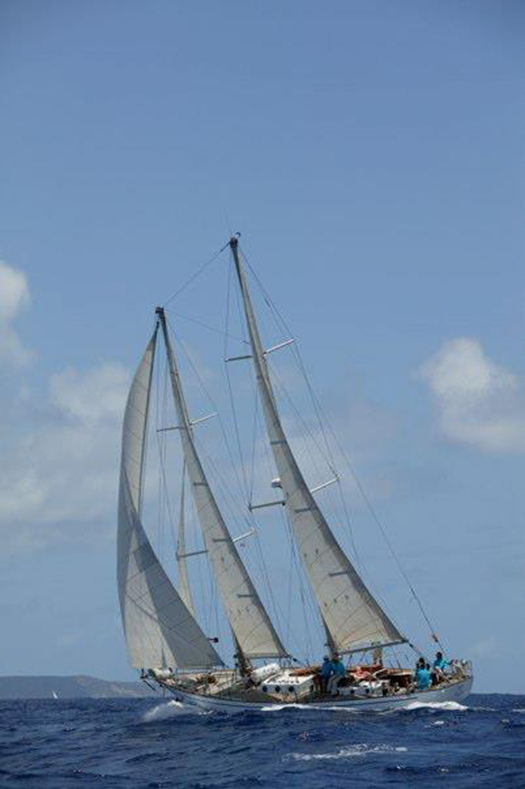
Spirit of Oysterhaven has been doing great work in keeping sail training alive in Ireland
But having the ship is one thing, paying the fees for the trainees to be aboard is something else, and sail training bursaries are one of the key areas of expansion in current maritime development in Ireland. There was an unusual turn to this in 2014 when somebody came up with the bright idea of using Irish Cruising Club funds (which are generated by the surplus from the voluntary production of the club's Sailing Directions) to provide bursaries for youngsters to take part in last summer's ICC 85th Anniversary Cruise-in-Company along the southwestern seaboard on Spirit of Oysterhaven.
The idea worked brilliantly, and this concept of neatly-tailored sail training bursaries is clearly one which can be usefully developed. But still and all, while it's great that young Irish people are being assisted in getting berths aboard charismatic vessels like Europa, the feeling that we should have our own proper sail training ship again is gradually gaining traction, and this is where the Atlantic Youth Trust comes in.
The AYT had its inaugural general meeting in Belfast as recently as the end of September 2014, so it may not yet have come up on your radar. But as it has emerged out of the Pride of Ireland Trust which in turn emerged from the Pride of Galway Trust, you'll have guessed that Enda O'Coineen and John Killeen are much involved, and they've roped in some seriously heavy hitters from both sides of the border, either as Board Members or backers, and sometimes as both.
The cross-border element is central to the concept of building a 40 metre three-masted barquentine, a size which would put her among the glamour girls in Class A, and could carry a decidedly large complement of 40 trainees, even if you're inevitably talking of stratospheric professional crewing costs.
However, by going straight in at top government level on both sides of the border, the AYT team are finding that they're pushing at a door which wants to open, particularly after the new Stormont House agreement was reached in the last days of 2014 to bring a more enthusiastic approach both to cross-community initiatives in the north, and cross border co-operation generally.
Who knows, but if they can succeed in getting cross-community initiatives working in Northern Ireland, then they may even be able to swing some sort of genuine Dublin-Cork shared enthusiasm in the Republic, for I've long thought that one of the factors in holding back many maritime initiatives in Ireland is that, while Dublin may be the political capital, Cork is quietly confident it's the real maritime capital, and does its own thing.
Be that as it may, the AYT have done serious studies, and their conclusion is the best scheme to learn from is the Spirit of Adventure programme in New Zealand. This is where the feeling of going back to the future arises, for in looking at photos of their ship Spirit of New Zealand, there's no escaping the thought that you're looking at Jack Tyrrell's concept ship of 1954 brought superbly to life.
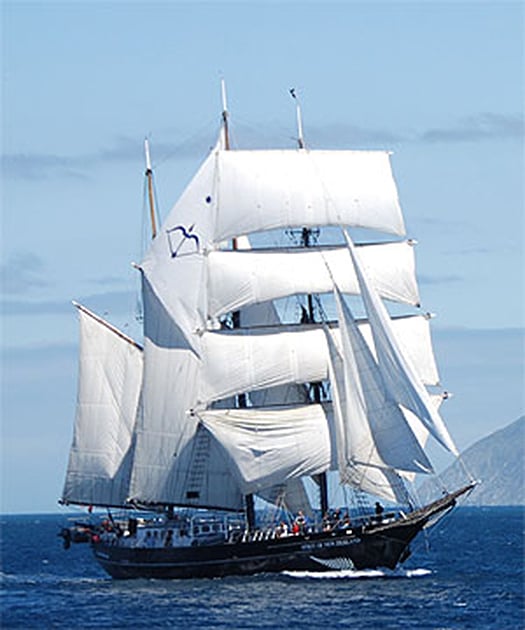
Spirit of New Zealand

Spirit of New Zealand almost seems like a vision of 1954 brought to life...

.....and that vision is Jack Tyrrell's 1954 concept for a 110ft sail training ship
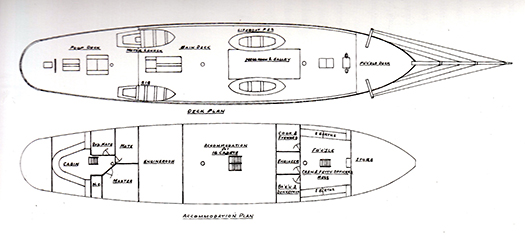
The 1954 accommodation drawings for the 110ft ship hark back to a more rugged age. Imagine the difficulties the ship's cook would face trying to get hot food from his galley on deck amidships all the way back to the officers in their mess down aft
We needn't necessarily agree with all the AYT's basic thinking For instance, they assert that Ireland is like New Zealand is being an isolated smallish island. It depends what you mean by "isolated". Those early sail training pioneers, the Vikings, certainly didn't think of Ireland as isolated. They thought it was central to the entire business of sailing up and down Europe's coastline.
Thus any all-Ireland sail training vessel would be expected to be away abroad at least as much as she'd be at home, whereas Spirit of New Zealand is usually home – the season of 2013-2014 was the first time she'd been to Australia since 1988, when she was in the fleet with Asgard II for the First Feet celebrations.
In New Zealand, she's a sort of floating adventure centre, and a large tender often accompanies her to take the trainees to the nearest landing place for shoreside adventures, for it's quite a challenge keeping 40 energetic young people fully occupied.
In Europe, that's where the sail training races come in. Time was when the racing aspect was down-played. But there's nothing like a good race to bring a mutinous crew together, and the recently-published mega-book about the world's sail training vessels, Tall Ships Today by Nigel Rowe of Sail Training International, quite rightly devotes significant space to everything to do with the racing.
Thus if we do get a new sail training ship for Ireland, she'll have to sail well and fast. That was Asgard II's greatest virtue. For there is nothing more dispiriting for troubled young folk than to find themselves shackled to the woofer of the fleet. Yet you'd be pleasantly surprised by how previously disengaged youngster can become actively and enthusiastically involved when they find that they're being transformed from scared and seasick kids into members of a winning crew.
So now, the 64 thousand dollar question. The cost. It's rather more than 64 thousand. AYT reckon they'll have to come up with a final capital expenditure of €15 million to build the ship and get her into full commission with proper crewing and shoreside administration arrangements in place. But after that – and here's the kernel of the whole concept – they reckon that the running costs will come out of existing government expenditure already in place and used every year for education, youth training, sporting facilities, social development and so forth.
So their pitch is that if the governments north and south come up with funding to support substantial donations already proposed for AYT by various benevolent national and international bodies, then once the ship is in being, she will generate her own income in the same way as vessels like Europa and Morgen Stern are already doing in mainland Europe.
And it's to the heart of mainland Europe that they'll be looking for design and contruction, as it's the Dykstra partnership which will be overseeing the design, and their ship-build associate company Damen will likely do the construction work, though one idea being floated is that Damen might provide a flatpack kit for the vessel to be built in steel in Ireland.
Those of us who dream of Asgard II being built anew will find all this a bit challenging to take on board. My own hopes, for instance, would still be to build Asgard II again to Jack Tyrrell's lines, but with the hull constructed in aluminium. It would be expensive as it would need to be double-skin below the waterline, but the ship's size would be very manageable with a professional crew of just five, while she'd sail like a dream And proper top-class marine grade aluminium seems to last for ever, as naval architect Gerry Dijkstra (his surname is slightly different from that of the partnership) himself shows with his remarkable cruises with his own-designed alloy 54-footer Bestevaer.
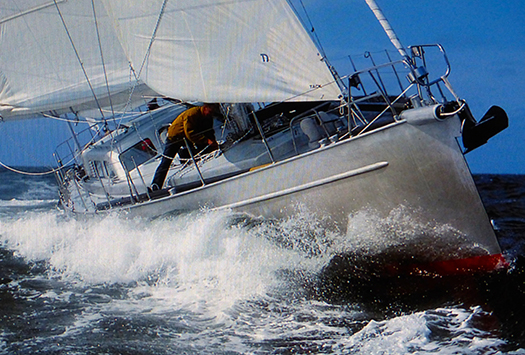
A man who knows what he's doing. This is Gerry Dijkstra's own extensively-cruised alloy-built 54 footer Bestevaer. The name translates not as "Best ever", but either as "best father" or "best seafarer", and was the name of affection given to the great Admiral de Ruyter by his loyal crews
Whatever, the good news is that things are on the move, and we wish them well, all those who have kept the Irish sail training flame alive through some appalling setbacks. Now, it really is the time to move forward. And if we do get a new ship, why not call her the Jack Tyrrell? He, of all people, was the one who kept the faith and the flame alive.
- Tall ship
- Belfast
- Jack Tyrell
- Kristiansand
- Aalesund
- Titanic
- maritime
- Class A
- square riggers
- George Stage
- Alexander Von Humboldt
- Christian Radich
- Sorlandet
- Shtandart
- Brigantine
- Asgard II
- Elaine Byrne
- Erskine Childers
- Sean Flood
- Naval
- Afloat magazine
- boatyard
- sail training ship
- Coiste an Asgard
- Charlie Haughey
- Colm Newport
- Irish Cruising Club
- Spirit of Oysterhaven
- Enda O'Coineen
- John Killeen
- Dykstra



























